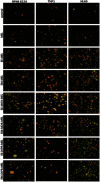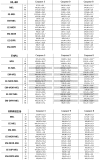Chemical modification of melphalan as a key to improving treatment of haematological malignancies
- PMID: 32161295
- PMCID: PMC7066245
- DOI: 10.1038/s41598-020-61436-x
Chemical modification of melphalan as a key to improving treatment of haematological malignancies
Abstract
Chemical modification of known, effective drugs is one method to improve chemotherapy. Thus, the object of this study was to generate melphalan derivatives with improved cytotoxic activity in human cancer cells (RPMI8226, HL60 and THP1). Several melphalan derivatives were synthesised, modified in their two important functional groups. Nine analogues were tested, including melphalan compounds modified: only at the amino group, by replacing the amine with an amidine group containing a morpholine ring (MOR-MEL) or with an amidino group and dipropyl chain (DIPR-MEL); only at the carboxyl group to form methyl and ethyl esters of melphalan (EM-MEL, EE-MEL); and in a similar manner at both functional groups (EM-MOR-MEL, EE-MOR-MEL, EM-DIPR-MEL, EE-DIPR-MEL). Melphalan derivatives were evaluated for cytotoxicity (resazurin viability assay), genotoxicity (comet assay) and the ability to induce apoptosis (terminal deoxynucleotidyl transferase dUTP nick end labelling, TUNEL, phosphatidylserine externalisation, chromatin condensation, activity of caspases 3/7, 8 and 9 and intracellular concentration of calcium ions) in comparison with the parent drug. Almost all derivatives, with the exception of MOR-MEL and DIPR-MEL, were found to be more toxic than melphalan in all cell lines evaluated. Treatment of cultures with the derivatives generated a significant higher level of DNA breaks compared to those treated with melphalan, especially after longer incubation times. In addition, all the melphalan derivatives demonstrated a high apoptosis-inducing ability in acute monocytic and promyelocytic leukemia cells. This study showed that the mechanism of action of the tested compounds differed depending on the cell line, and allowed the selection of the most active compounds for further, more detailed investigations.
Conflict of interest statement
The authors declare no competing interests.
Figures








References
Publication types
MeSH terms
Substances
LinkOut - more resources
Full Text Sources

